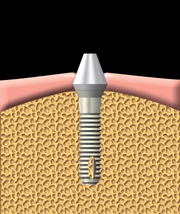

There are several techniques to replace one or more teeth, including the bridge, the dental prosthesis and the dental implant. An implant is an artificial root made of titanium that is inserted into the jawbone to replace the natural tooth root. The dental implant serves as a pillar to hold a replacement artificial tooth attached to the implant.
The dentist will perform an examination with an X-ray to determine if the placement of a dental implant is feasible. If so, he will perform a two-step surgery. The first step is to insert a dental implant into the jawbone, under the gum tissue and suture it to that tissue. The goal is for the implant to integrate with the bone and attach to the gum. The second step is to attach a pillar to the implant that will support the replacement tooth. In some cases, these two steps will be carried out in a single visit. Then the replacement tooth will be attached to the abutment. If you need to replace several teeth, fixing a bridge on your implants will be necessary.
It will depend on the health of your mouth. If your gums are healthy and the bone base of your jawbone is large enough to support an implant, then a dental implant is an option. Note that if you do not have enough bone mass, a bone graft can be performed.

An abutment is attached to the implant


Factors such as age, smoking or periodontal disease can influence the reduction of your bone volume in your jaw. Bone grafting is a good solution for patients who wish to have a dental implant, but who do not have sufficient bone volume. Bone grafting is a safe and generally uncomplicated procedure. The dentist will apply local anesthesia to the area in question. Then he will make an incision and then fix the bone graft. This graft will be covered with a synthetic membrane that will both isolate it and keep it in place while stimulating bone growth. The dentist will give you advice to reduce the pain that could occur following the operation.
If you are missing one or more teeth in your upper jaw, the bone may shrink and gradually disappear and give more space to the tissues of the maxillary sinus which is located above the jaw. A thin layer of bone is then present to separate your mouth and sinus. In this context, your dentist will perform a sinus lift to prepare your jaw to receive a dental implant. He will then perform an operation under local anesthesia, in order to clear the sinus by lifting the tissues located inside the sinus and restore bone mass to your jawbone with a bone graft.


There are two types of implant restoration. If you have a single missing tooth, an implant can be placed to create an artificial root for the replacement tooth, more commonly called a crown. If you have several teeth to replace, in this case the implant will serve as a solid base for a partial prosthesis on implants. This prosthesis will generally be fixed on two implants. In both cases, the implant represents a durable solution and offers great stability to all types of restoration.
If you are missing all your teeth in the upper and lower jaws, a fixed or removable implant-supported prosthesis could be a solution. Our dentists at the Cousineau dental center have solid experience in implantology and denturology to manufacture dental prostheses on implants. This type of prosthesis can replace all your teeth and is fixed on four implants. This provides both stability and stimulation of the jawbone that would lose volume without implants.